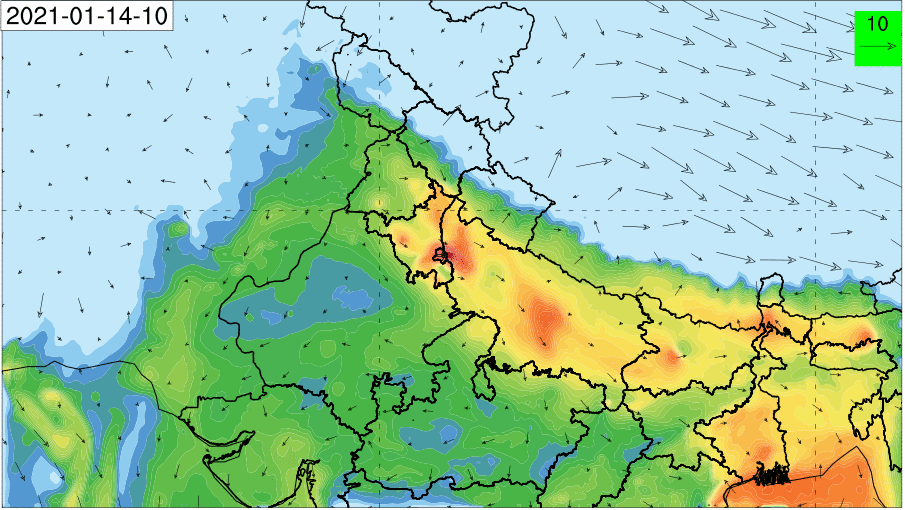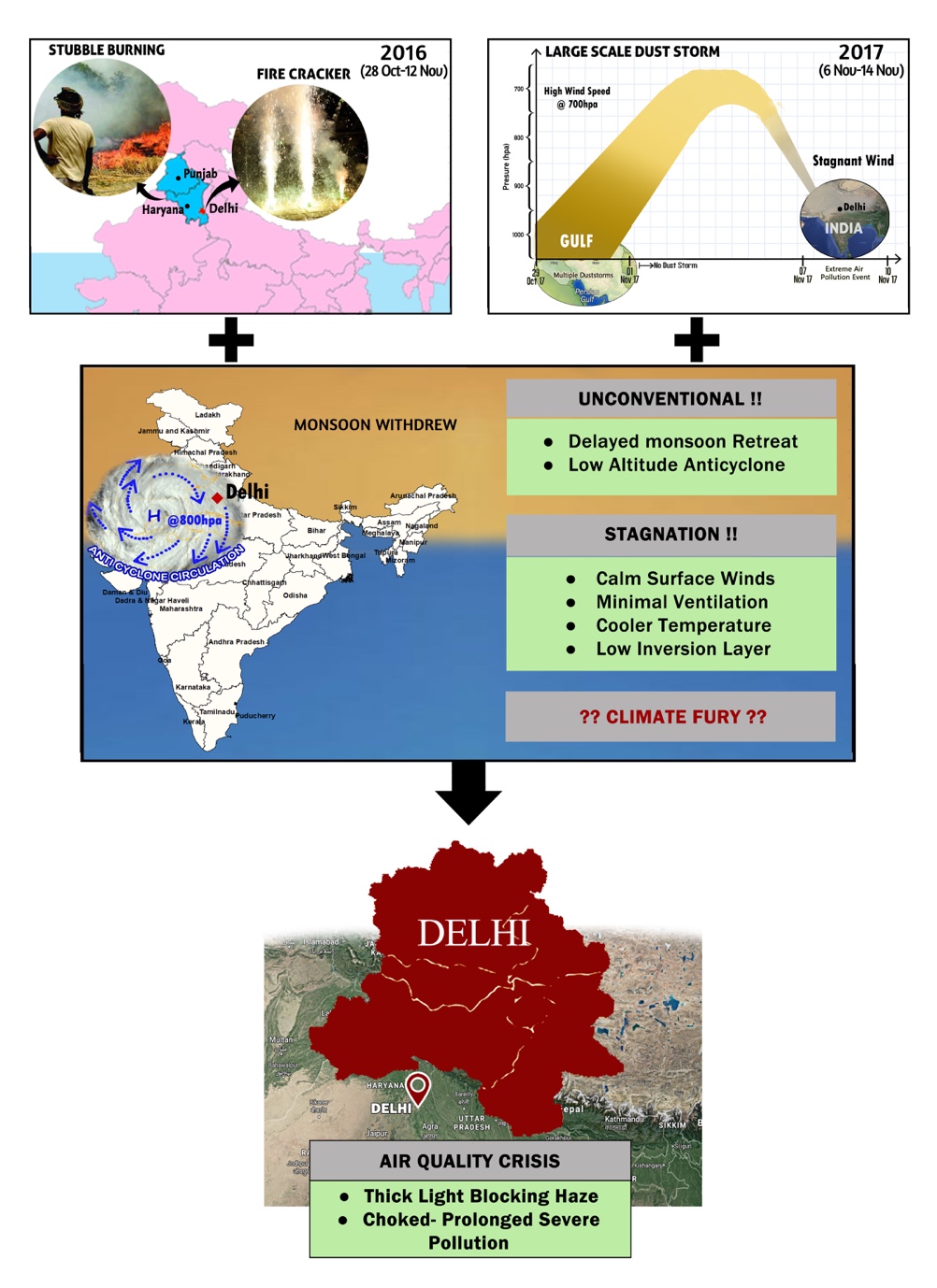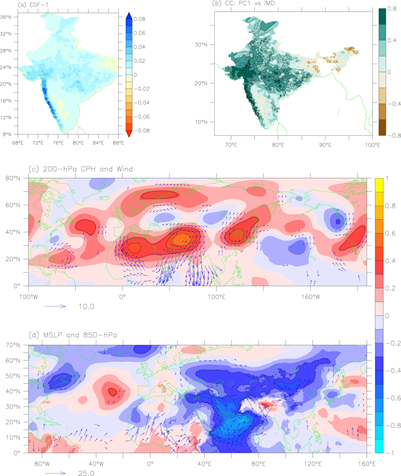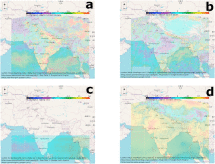RAC Poster Session
Training in AI/ML Videos
Seminars / Lectures
IITM Publication Highlights
An observing system simulation experiment for Indian Ocean surface pCO2 measurements
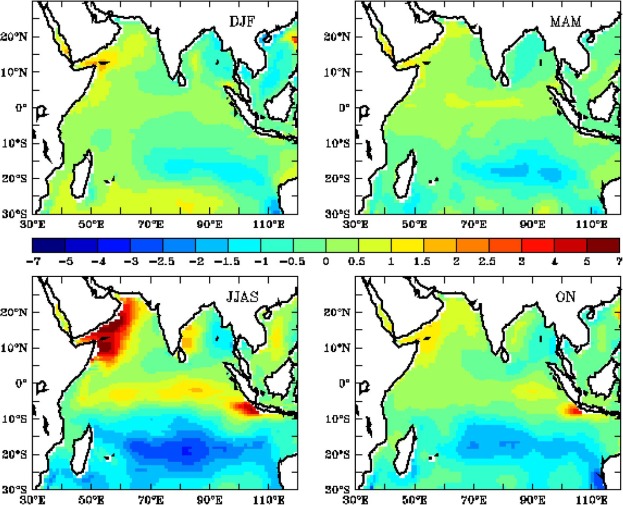 Surface ocean partial pressure of CO2 (pCO2) information is vital for estimating sea-to-air CO2 exchanges. This parameter is least available from the Indian Ocean as compared to other global tropical and southern oceans. The study finds that the existing moorings of the Indian Ocean are capable of hosting pCO2 sensors, and data from those are useful to reduce the uncertainty in the surface sea-to-air CO2 flux estimation by a quarter magnitude. In contrast, the Bio-Argo floats with pH sensors, and the ship of opportunity underway sampling of pCO2 may benefit from reducing the same up to 50% and 62%, respectively.
Surface ocean partial pressure of CO2 (pCO2) information is vital for estimating sea-to-air CO2 exchanges. This parameter is least available from the Indian Ocean as compared to other global tropical and southern oceans. The study finds that the existing moorings of the Indian Ocean are capable of hosting pCO2 sensors, and data from those are useful to reduce the uncertainty in the surface sea-to-air CO2 flux estimation by a quarter magnitude. In contrast, the Bio-Argo floats with pH sensors, and the ship of opportunity underway sampling of pCO2 may benefit from reducing the same up to 50% and 62%, respectively.
( Valsala V., Sreeush M.G., Anju M., Sreenivas P., Tiwari Y.K., Chakraborty K., Sijikumar S., Progress in Oceanography, June 2021, DOI: 10.1016/j.pocean.2021.102570)
Year-long concurrent MAX-DOAS observations of nitrogen dioxide and formaldehyde at Pune: understanding diurnal and seasonal variation drivers
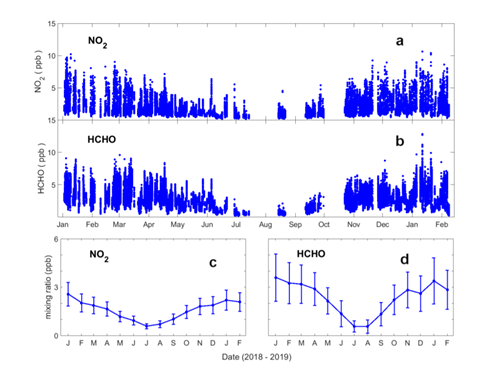 Year-long observations of nitrogen dioxide (NO2) and formaldehyde (HCHO) using the Multi-Axis Differential Absorption Spectroscopy (MAX-DOAS) technique are reported from Pune City, India. Diurnal and seasonal variations, effect of biomass burning and the weekend effect on both species were studied. NO2 diurnal profiles displayed a traffic induced peak at ~09:00 hrs. HCHO also showed a morning peak ~10:00 hrs due to production from oxidation of VOCs in the presence of solar radiation. Both HCHO and NO2 concentrations are lower in Pune compared to the other large cities in India.
Year-long observations of nitrogen dioxide (NO2) and formaldehyde (HCHO) using the Multi-Axis Differential Absorption Spectroscopy (MAX-DOAS) technique are reported from Pune City, India. Diurnal and seasonal variations, effect of biomass burning and the weekend effect on both species were studied. NO2 diurnal profiles displayed a traffic induced peak at ~09:00 hrs. HCHO also showed a morning peak ~10:00 hrs due to production from oxidation of VOCs in the presence of solar radiation. Both HCHO and NO2 concentrations are lower in Pune compared to the other large cities in India.
(Biswas M.S., Mahajan A.S., Aerosol and Air Quality Research, June 2021, DOI:10.4209/aaqr.200524)
Association of Retreating Monsoon and Extreme air Pollution in a Megacity
Highlights of the study:
i. Paper presents a hypothesis and validates using the madden SAFAR model that the Asian summer monsoon dynamics of delayed withdrawal time and associated anti-cyclonic circulation playing a lead role in enhancing the frequency of extreme pollution events by triggering rapid particulate formation and trapping them ceaselessly.
ii. Present findings suggest that such unusual monsoon patterns are on the hook to spur extreme pollution events in recent time.
(Beig G., Rathod Aditi, Tikle S., Maji Sujit, Sobhana S.B., Journal of Environmental Sciences, August 2021, DOI:0.1016/j.jes.2021.01.004)
Analysis of atmospheric ammonia over South and East Asia based on the MOZART-4 model and its comparison with satellite and surface observations
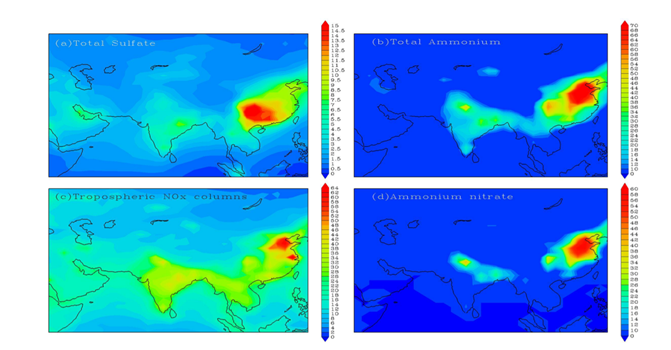 In this study, simulations of atmospheric ammonia (NH3) with MOZART-4 and HTAP-v2 are compared with satellite (IASI) and ground-based measurements to understand the spatial and temporal variability of NH3 over two emission hotspot regions of Asia, the IGP and the NCP. Our simulations indicate that the formation of ammonium aerosols is quicker over the NCP than the IGP, leading to smaller NH3 columns over the higher NH3-emitting NCP compared to the IGP region for comparable emissions.
In this study, simulations of atmospheric ammonia (NH3) with MOZART-4 and HTAP-v2 are compared with satellite (IASI) and ground-based measurements to understand the spatial and temporal variability of NH3 over two emission hotspot regions of Asia, the IGP and the NCP. Our simulations indicate that the formation of ammonium aerosols is quicker over the NCP than the IGP, leading to smaller NH3 columns over the higher NH3-emitting NCP compared to the IGP region for comparable emissions.
(Pawar P.V., Ghude S.D., Jena C., Móring A., Sutton M.A., Kulkarni S., Lal D.M., Surendran D., Van Damme M., Clarisse L., Coheur P.-F., Liu X., Govardhan G., Xu W., Jiang J., Adhya T.K., Atmospheric Chemistry and Physics, April 2021, DOI:10.5194/acp-21-6389-2021)
Multi-Model Multi-Physics Ensemble: A Futuristic Way to Extended Range Prediction System
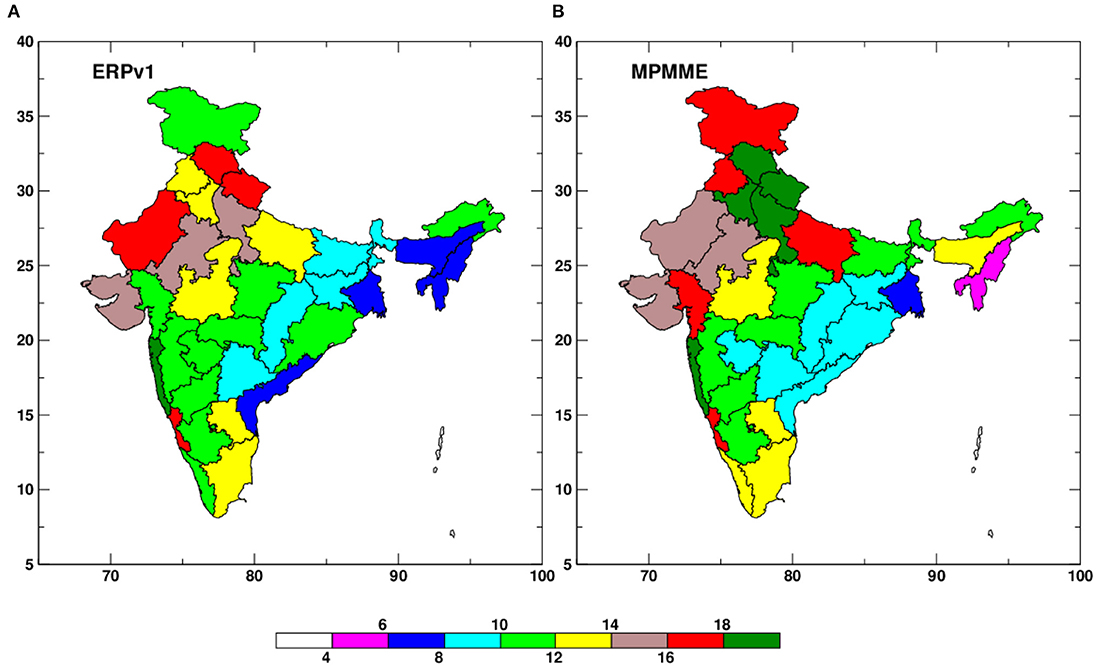 The study highlights the strength of the physics-based multi-model extended range ensemble prediction system over its predecessor operational version in predicting ISMR. The skill of MPMME and ERPv1 for ISMR is compared using different verification scores for spatiotemporal forecast evolution at weekly leads. This new MPMME framework distinguishes itself from the ERPv1 in its single seamless horizontal resolution, for considering multiple realizations of atmospheric dynamics achieved by permutations of convection and microphysics parameterizations.
The study highlights the strength of the physics-based multi-model extended range ensemble prediction system over its predecessor operational version in predicting ISMR. The skill of MPMME and ERPv1 for ISMR is compared using different verification scores for spatiotemporal forecast evolution at weekly leads. This new MPMME framework distinguishes itself from the ERPv1 in its single seamless horizontal resolution, for considering multiple realizations of atmospheric dynamics achieved by permutations of convection and microphysics parameterizations.
(Sahai A.K., Kaur Manpreet, Joseph S., Dey Avijit, Phani R., Mandal R., Chattopadhyay R., Frontiers in Climate, May 2021, DOI:10.3389/fclim.2021.655919) 
New Publications
Tropical Indian Ocean and ENSO relationships in a changed climate
Marathe S., Terray P., Karumuri A., Climate Dynamics, May 2021, DOI:10.1007/s00382-021-05641-y
Relationship between Azores High and Indian summer monsoon
Yadav R.K., npj Climate and Atmospheric Science, April 2021, DOI: 10.1038/s41612-021-00180-z
Quantifying COVID-19 enforced global changes in atmospheric pollutants using cloud computing based remote sensing
Singh Manmeet, Singh B.B., Singh R., Upendra B., Kaur R., Gill S.S., Biswas M.S., Remote Sensing Applications: Society and Environment, April 2021, DOI:10.1016/j.rsase.2021.100489
Assessment of APCC models fidelity in simulating the Northeast monsoon rainfall variability over Southern Peninsular India
Prasanna K., Chowdary J.S., Singh Prem, Chiranjeevi D., Naidu C.V., Parekh A., Gnanaseelan C., Theoretical and Applied Climatology, May 2021, DOI:10.1007/s00704-021-03559-3
PDF Publisher LinkIITM Events

Azadi Ka Amrit Mahotsav: Special Lecture in Marathi,
25 May 2021 at 16.00 hrs
Topic: कृत्रिम पाऊस: विज्ञान, तंत्रज्ञान, फायदा, आणी काही गैरसमज (Cloud seeding: science, technology, benefits, and some misunderstandings)
Speaker: डॉ. जे. आर. कुलकर्णी/ Dr. J.R. Kulkarni, Retired IITM Senior Scientist and Ex-President of ISMP
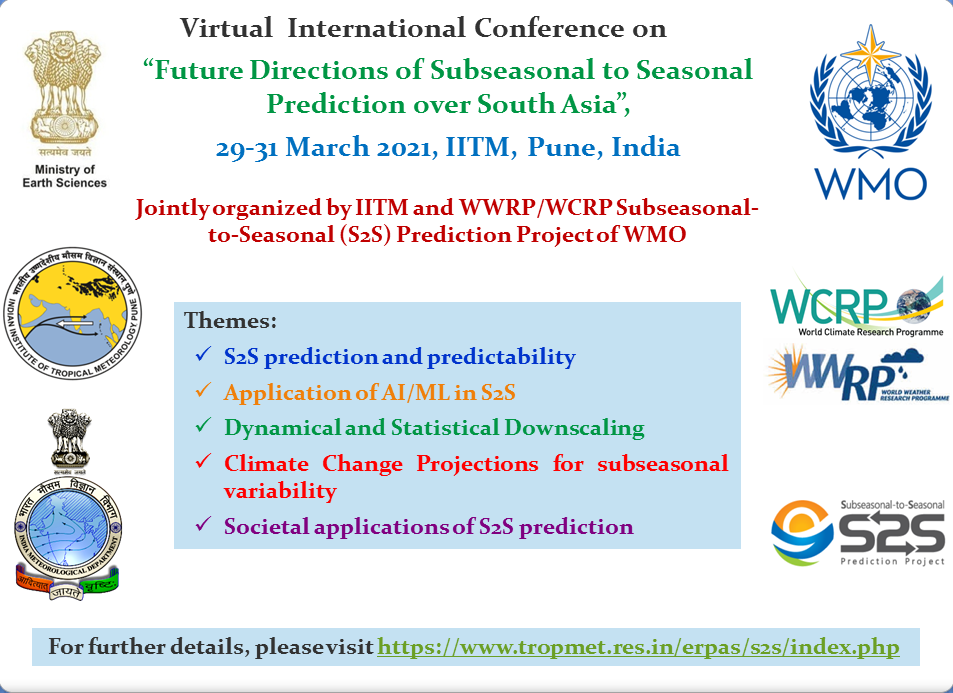
Virtual International Conference on the “Future directions of Subseasonal to Seasonal Prediction over South Asia”
IITM, Pune and the WWRP/WCRP Subseasonal-to-Seasonal (S2S) Prediction Project organized a Virtual International Conference on the "Future directions of Subseasonal to Seasonal Prediction over South Asia".


